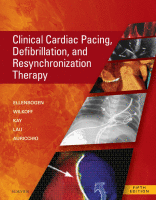Physical Address
304 North Cardinal St.
Dorchester Center, MA 02124

The need to replace the pulse generator of a pacemaker or a defibrillator may occur at any time in the life of a patient implanted with one of these devices. Although this need is most often the result of normal…

Introduction Cardiac implantable electronic devices (CIEDs) have proven to be an invaluable tool in the practice of cardiology, and implantation rates continue to rise. For this reason, the number of CIEDs in use and the inevitable complications associated with these…

The first generation of cardiac implantable electronic devices (CIEDs) were implanted by surgeons, initially with epicardial and later transvenous pacing systems. Because of this, when problems were encountered the solution was a surgical technique. As devices became smaller and almost…

Background Cardiac resynchronization therapy (CRT) has proved a highly effective treatment for many patients suffering from heart failure. The nonresponder rate in many series is, however, still in the 30% range. There are many facets to the issue of “nonresponse.”…

Introduction Cardiac resynchronization therapy (CRT) reduces hospitalization, improves quality of life, and lowers mortality in selected patients with congestive heart failure (CHF). CRT requires left ventricular (LV) pacing, usually via a lead placed transvenously through a coronary vein on the…

The learning curve for implantation of cardiac implantable electronic devices (CIEDs) can be challenging due to the need to acquire surgical, lead, and catheter handling skills, as well as the ability to identify normal and abnormal CIED component function in…

The approach to implantable cardioverter-defibrillator (ICD) implantation has evolved ever since the first implant in the 1980s. The latest technical advancement is the development of the subcutaneous ICD (S-ICD) with an entirely subcutaneous lead. Although transvenous ICDs are highly effective…

Cardiac rhythm device therapy is valuable for treatment of bradyarrhythmias and tachyarrhythmias in patients of all ages. Pediatric and young adult patients may present additional challenges during evaluation of implant indications such as selection of an approach to lead placement,…

The implantation of cardiac implantable electronic devices (CIEDs), including pacemakers, implantable cardioverter-defibrillators (ICDs), cardiac resynchronization therapy (CRT) devices (CRT-D, CRT-P), and implantable monitors, has evolved substantially during the past six decades. The initial epicardial, and even transvenous, pacemaker and ICD…

Ambulatory electrocardiography is used to continuously monitor a patient's heart rhythm over an extended period, encompassing normal activity and exercise and usual physiologic changes. It has demonstrated increased sensitivity compared with the standard electrocardiogram (ECG) for detecting spontaneous cardiac arrhythmia.…